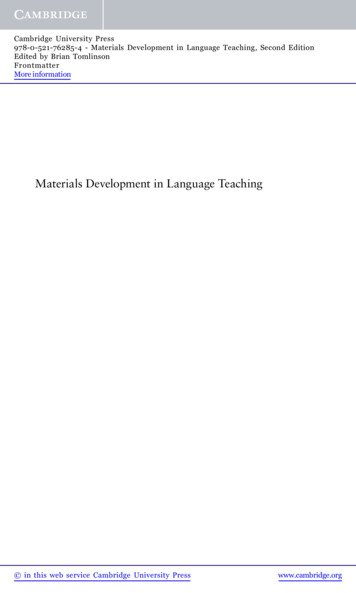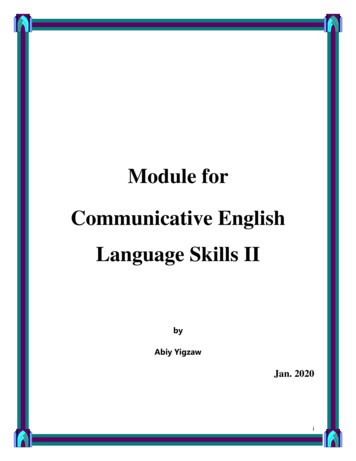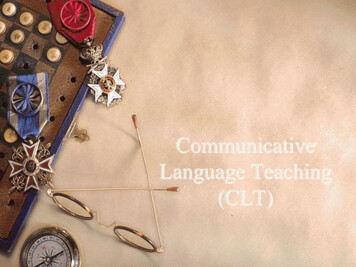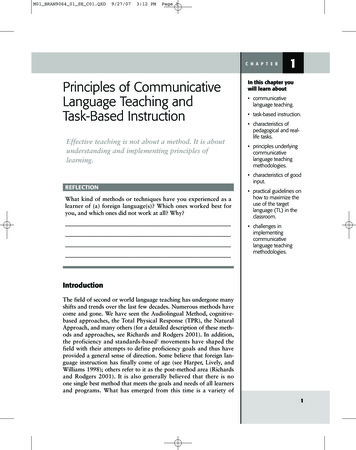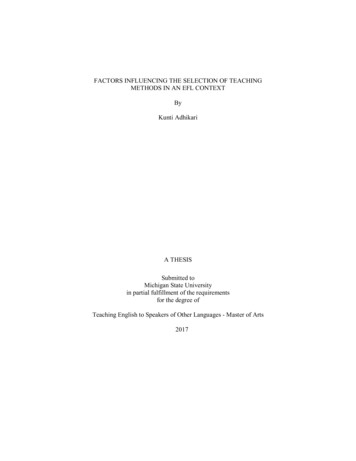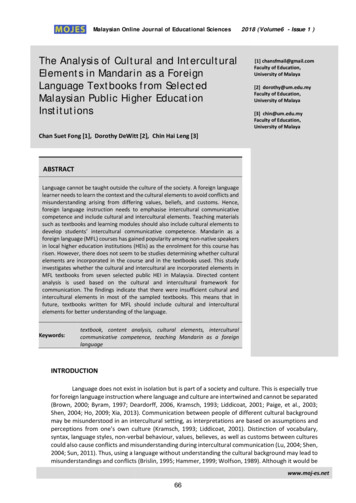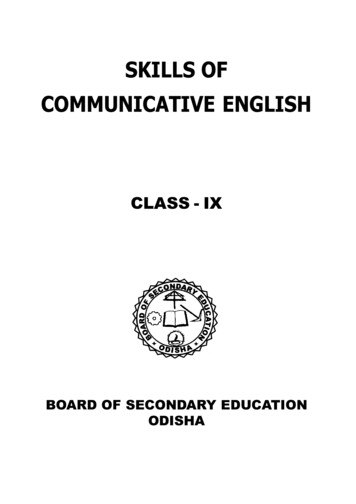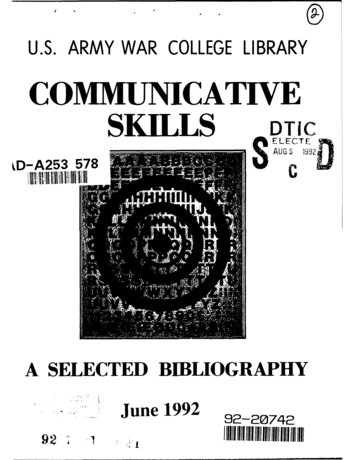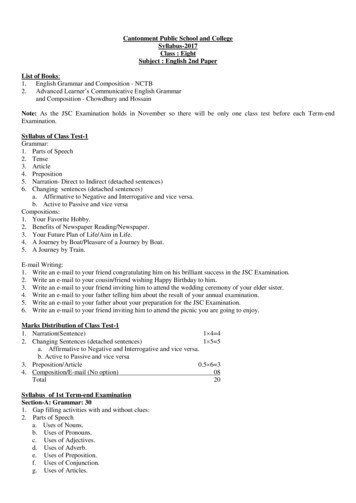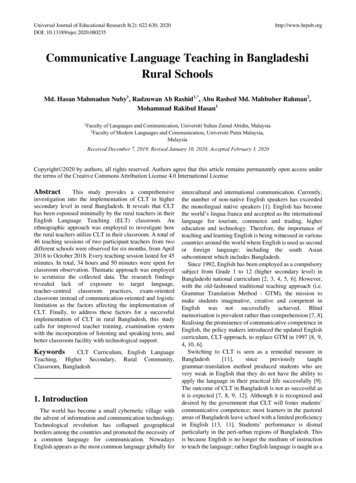
Transcription
Universal Journal of Educational Research 8(2): 622-630, 2020DOI: nicative Language Teaching in BangladeshiRural SchoolsMd. Hasan Mahmadun Nuby1, Radzuwan Ab Rashid1,*, Abu Rashed Md. Mahbuber Rahman2,Mohammad Rakibul Hasan11Faculty of Languages and Communication, Universiti Sultan Zainal Abidin, Malaysia2Faculty of Modern Languages and Communication, Universiti Putra Malaysia,MalaysiaReceived December 7, 2019; Revised January 10, 2020; Accepted February 3, 2020Copyright 2020 by authors, all rights reserved. Authors agree that this article remains permanently open access underthe terms of the Creative Commons Attribution License 4.0 International LicenseAbstractThis study provides a comprehensiveinvestigation into the implementation of CLT in highersecondary level in rural Bangladesh. It reveals that CLThas been espoused minimally by the rural teachers in theirEnglish Language Teaching (ELT) classroom. Anethnographic approach was employed to investigate howthe rural teachers utilize CLT in their classroom. A total of46 teaching sessions of two participant teachers from twodifferent schools were observed for six months, from April2018 to October 2018. Every teaching session lasted for 45minutes. In total, 34 hours and 50 minutes were spent forclassroom observation. Thematic approach was employedto scrutinize the collected data. The research findingsrevealed lack of exposure to target language,teacher-centred classroom practices, exam-orientedclassroom instead of communication-oriented and logisticlimitation as the factors affecting the implementation ofCLT. Finally, to address these factors for a successfulimplementation of CLT in rural Bangladesh, this studycalls for improved teacher training, examination systemwith the incorporation of listening and speaking tests, andbetter classroom facility with technological support.KeywordsCLT Curriculum, English LanguageTeaching, Higher Secondary, Rural Community,Classroom, Bangladesh1. IntroductionThe world has become a small cybernetic village withthe advent of information and communication technology.Technological revolution has collapsed geographicalborders among the countries and promoted the necessity ofa common language for communication. NowadaysEnglish appears as the most common language globally forintercultural and international communication. Currently,the number of non-native English speakers has exceededthe monolingual native speakers [1]. English has becomethe world’s lingua franca and accepted as the internationallanguage for tourism, commerce and trading, highereducation and technology. Therefore, the importance ofteaching and learning English is being witnessed in variouscountries around the world where English is used as secondor foreign language; including the south Asiansubcontinent which includes Bangladesh.Since 1992, English has been employed as a compulsorysubject from Grade 1 to 12 (higher secondary level) inBangladeshi national curriculum [2, 3, 4, 5, 6]. However,with the old-fashioned traditional teaching approach (i.e.Grammar Translation Method - GTM), the mission tomake students imaginative, creative and competent inEnglish was not successfully achieved. Blindmemorisation is prevalent rather than comprehension [7, 8].Realising the prominence of communicative competence inEnglish, the policy makers introduced the updated Englishcurriculum, CLT approach, to replace GTM in 1997 [8, 9,4, 10, 6].Switching to CLT is seen as a remedial measure slation method produced students who arevery weak in English that they do not have the ability toapply the language in their practical life successfully [9].The outcome of CLT in Bangladesh is not as successful asit is expected [7, 8, 9, 12]. Although it is recognized anddesired by the government that CLT will foster students’communicative competence; most learners in the pastoralareas of Bangladesh leave school with a limited proficiencyin English [13, 11]. Students’ performance is dismalparticularly in the peri-urban regions of Bangladesh. Thisis because English is no longer the medium of instructionto teach the language; rather English language is taught as a
Universal Journal of Educational Research 8(2): 622-630, 2020subject and instructed with the native language instead ofEnglish [9]. Teachers and students do not feel the urge tocommunicate in English because the main goal of teachingand learning is to pass examination and in the currentexamination system, there is no provision of testinglistening and speaking skills [13, 14, 15]. Therefore,students receive neither the direct touch of grammar asoffered by GTM nor the fullest supposed benefits fromCLT [16]. Along with proficiency, students’ reading andwriting skills are also deteriorating as reflected in the highfailure rate in English than in other subjects in thenationwide public examinations [7, 11, 17, 18].This old-fashioned approach of testing format createsshrinkage in the execution of the curriculum and this is aclear indication that the assessment system is inconsistentwith the national policy and curriculum [4, 19].The provision of professional training and developmentprogrammes for teachers are also inadequate [10, 11, 13,19]. During the inception of CLT, teachers were theproduct of GTM and without providing any prior trainingor considering the local teachers’ opinion, CLT wasimposed on them [19,20]. Consequently, teaching-learningobjectives are not achieved due to the poor performance ofthe teachers [10, 21]. Teachers who are not well preparedand trained will not be able to make effective use of theteaching materials no matter how well they are designed[22]. Moreover, a curriculum implemented using top downapproach is not efficient [23]. In line with this, Das,Shaheen, Shrestha, Rahman and Khan [24] and Rahman etal. [10] argue that the principles of CLT and teachers’practices are incompatible and teachers do not have clearidea about CLT curriculum rather mixed estimation aboutits implementation.Studies have also shown that difficult teachingenvironment, such as unusually large class size, limitedclass time, lack of teaching materials, and poorinfrastructure contribute to the hindrance of CLTimplementation [5,6,10,25]. However, many scholars thinkthat teachers are at the core of effective curriculumexecution [23,26]. In the classroom, it is the teachers whoimplement the curriculum [27]. Therefore, the presentstudy aims to investigate the practice of CLT by addressingthe research question: How do teachers employ CLTapproach at higher secondary level in the EFL classroom inrural Bangladesh?In the words of Ellis [28] “language learning requires thedetailed investigation of usage, its content, its participants,and its contexts” (p.39). Therefore, it is crucial to explorecurrent practices to ensure the best practices of CLT.Despite the comprehensive research in CLT application,limited research has been done in the rural environments ofBangladesh. Since rural teachers’ activities may vary fromurban teachers’ activities, it is worth considering their rolesin CLT implementation. This study is important as it couldbe used as a resource that gives a vivid picture of CLTimplementation of Bangladeshi rural EFL context.6231.2. CLT in Different ESL/ EFL CommunityThe shift from grammar-focused instruction to CLT incurriculum implementation has been the subject of ,33,34,35,36,37,38].The study of Athawadi [31] shows that the absence ofteaching resources, teacher training, non-qualified learnersand education system hinders CLT implementation inLibyan university English classes. The study calls foradequate in-service training for teachers to improve theimplementation of CLT. In Ecuador, Toro et al. [38]indicate that pair work, group work, modelling andrepetition are not enough to promote active classroomparticipation as these learning strategies are not properlyexecuted. The study suggests the employment of strategieslike metalinguistic feedback and elicitation, which canbenefit students to develop their oral skills. Luo and Garner[33] in China assert that due to the deeply Confucianculture, learners are preoccupied with passive learningfrom the teacher instead of engaging in active participation.Similarly, Smith [36] reveals that Japanese learners aretypically reserved and they are unwilling to interact inEnglish because they feel they are bad English speakers. InJapan, grammar-focused examinations, influence oftraditional teaching methods and the university entranceexams pressure are the reasons which affect CLTimplementation [35,37]. The study of Mason and Payant[34] discloses that teachers’ belief and practice are notaligned as well as contextual issues hinder CLTimplementation in Educator. In Indonesia, Susanto [39]shows that the application of CLT is effective when it isincorporated with extracurricular activities. In the samevein, Astuti [29] and Astuti and Lammers [30] suggest theuse of Cooperative Learning (CL) to improvecommunicative competence. Whereas, Muthmainnah [40]proposes the idea of English Corner, an arranged space topractice English for improving students’ English skill inIndonesia.1.3. Communicative Language Teaching (CLT)The root of CLT is found in Hymes’ ‘communicativecompetence’ theory [1,41] in which he states thatcommunicative competence is the ability to use languageappropriately in different circumstances [42]. Centred onHymes’ communicative competence theory, in the lateseventies, Widdowson [43] developed the concept ofcommunicative language teaching [1]. Before this time,fundamental structures, Audio-Lingual Method (ALM)and Grammar Translation Method (GTM) were practisedwhen language teaching was utilised for teaching Englishas a foreign language in British Situational LanguageTeaching approach. CLT appeared as a result of thedissatisfaction of structural teaching method [25,44,45].CLT was embraced and implemented rapidly, as itgained reputation quickly in British language teaching
624Communicative Language Teaching in Bangladeshi Rural Schoolscircles which involve leading British applied linguists,textbook writers, specialists of language teaching,curriculum development centres, publishers, in addition toinstitutions, such as the British Council. Both Americanand British proponents recognized CLT as an approach thatemphasizes mainly on communicative competence andlearning integrated language skills for meaningfulcommunication [46].Over the years, many applied linguists have theorizedCLT. However, Richards and Rogers [46] propose that themost commonly recognized theories of CLT are: Emphasis should be placed on the assimilation ofmeaning, linguistic form and function. Learners should be involved in pragmatic, functionaland authentic use of language for meaningfulpurposes. Complementaryprinciplesunderlyingcommunicative methods are fluency and accuracy. Classroom teaching should focus on working in pairsor groups. Fluency and accuracy assessment should beconducted. The native language of the student should be avoided. The role of the teacher is to facilitate learning for thestudents.The key features of CLT have always been to emphasizemeaning over linguistic accuracy. CLT focuses onmeaningful oral and written operations to support learners’communication skills [47]. According to the teaching andlearning philosophy, it is contrary to the rigid grammarguidelines of GTM or repetitive drilling of the ALM. In aCLT classroom, the centre of power changes from teachersto learners by enabling them to communicate with eachother and providing learners with ample opportunities towork in pairs or groups. In doing so, teachers take on thefunction of facilitator rather than the centre-force of alanguage classroom [46].2. MethodologyThis study aims at exploring how English languageteachers implement CLT at higher secondary classroom inrural Bangladesh. The researchers employed a qualitativeresearch approach whereby data was collected fromclassroom observation to scrutinise the day-to-dayoperation of CLT at the two colleges located in theperi-urban region of Bangladesh. Applying interpretivetheoretical viewpoint, this qualitative enquiry helped togain an in-depth understanding of the phenomenon beinginvestigated. Creswell [48] denotes “a qualitative study isdefined as an inquiry process of understanding a social orhuman problem, based on building a complex, holisticpicture, formed with words, reporting detailed views ofinformants, and conducted in a natural setting (p.34)”. Thepaucity of existing research is that most of them usedinterview and questionnaire data to collect data [49].However, very few studies have tried to observe theclassroom as a tool to investigate what teachers do in theirclassroom [50]. Classroom observation is regarded as theheart of the qualitative research design in curriculumimplementation studies as it delivers first-hand informationon the execution of any programme [51].Ethnographic approach allows researchers to “capturethe character of naturally occurring human behaviour” by“first hand contact with it, not by inferences from whatpeople do in artificial settings like experiments” [52, p. 6].This prospect enables the researchers to provide a “thickdescription” [53 p. 316] of the phenomenon whereinformation was gathered from “up-close, personalexperience and possible participation, not just observation”[54, p. 1] of the participants’ real life environment for aconsiderable period of time [55].This study began data collection procedure with ELTclassroom observations of the two participant teachers oftwo colleges for six months (from April to October, 2018).The classroom observations were limited to two teachers oftwo different colleges so that more time could be spentwith them to gather rich insights into their practices of CLT.The colleges were selected based on the access availability.The English language classes were held four days out ofthe six working days in a week as only one Englishlanguage teacher was there in both colleges. As anon-participant observer, the first author observed 46teaching sessions of the two participant teachers toexamine the activities and tasks carried out. Creswell [48]states that a non-participant observer is an outsider of thegroup under study who can watch and take field notes froma distance without direct involvement. Regarding this,Hennink, Hutter and Bailey [56] suggest “non-participantobservation is not observing through deception but isobserving with a purpose and from a distance” (p. 185). Inaddition, classroom observation is a research method thatenables researchers to systematically observe and recordpeople’s behaviour, actions and interactions. The methodalso allows researchers to obtain a detailed description ofsocial settings or events in order to situate people’sbehaviour within their socio-cultural context [56, p.170].In other words, classroom observations will help theresearcher to involve with the real classroom settingswhere teachers’ actual role will be demonstrated ratherthan what they think to do. In line with this, Cohen, Manionand Morrison [57] argue that observation “enablesresearchers to see things that might otherwise beunconsciously missed, to discover things that participantsmight not freely talk about in interview situations” (p. 396).The observation over a period of six-months wasplanned with the aim of ensuring in-depth experience andunderstanding to grab the participants’ genuine activities,experience and emotion. At the same time, prolongedobservation reduces the researcher effect that the observercould have on the context. It was intended to make the
Universal Journal of Educational Research 8(2): 622-630, 2020teacher and students feel at ease so that they behave morenaturally in the presence of the researcher in the classroom.Moreover, the researcher did not set any video camera andtried not to make eye contact with the teachers and studentsduring class hour which could affect teachers’ and students’normal practices.After observing the lesson, the researcher tookphotographs of the classroom, textbook, teachers’ work,students’ work, and any posters, which were later used tointerpret the data. The collected data was written in theform of field notes which included the “descriptions ofcontexts, actions, and conversations” [58, p.77].2.1. Data AnalysisTo analyse the observation data, thematic approach wasapplied. The analysis is made up of topic selection,category selection and theme selection as recommended byLuttrell [61]. After transcribing data along with the fieldnotes, the researchers scrutinize the scripts to develop ageneral understanding of the participants’ practice of CLTin their contexts. The researchers acquainted themselveswith the field notes and data by continuously scanning thetranscribed data in an active way to search for patterns andmeanings [62]. This phase is named “topic selection” bythe researchers, as “topics” are identified in this phase fromthe data. ‘Using mother tongue’ is one such topic. Duringthe second review, the researchers determine the relationsamong the similar topics and put them in one category as“category selection”. A “category” is meant in this researchas a group of topics with common features that form asimilar larger concept [63]. Examples for such topics are“Teacher’s proficiency in English” and “Skippingcommunicative activities” that refers to the commonmatters observed in teachers in CLT implementation. Bothrefer to insufficient usage of target language and aretherefore grouped under the category “Using mothertongue instead of target language”. Once categories arelabelled, the study starts to scrutinise them again to definetheme that emerge across the data as “theme selection”.From this exercise themes are developed. Theme is definedin this study as a set of categories presenting a concept orquality that is unifying and recurrent.625major principles of CLT. However, Bangla wasdominantly used as the medium of instruction in the twoobserved schools. In CLT classroom, judicious use ofmother tongue is permitted but to explain tasks fromtextbook or communicative activities, target languageshould be used [64]. Throughout the observation period,the teachers were commonly found to read out the passagesof different lessons loudly for the learners and translatedthem into native language line by line. They wrote newwords on the board and explained word meaning in nativelanguage in their reading activities. Students hardly spokeEnglish. They used English only when they answeredquestions of any lesson which is basically based on theirmemorization. The objective of CLT approach is toimprove students’ speaking skill in the target language.Hence, it was expected that teachers would inspire studentsto speak in English in classroom and develop theirspeaking skill. In reality, the teachers were found to usenative language in all types of classroom activities andcommunication, let alone encouraging students. The studyof Rahman et al. [10], Roy [6], Trisha et al. [7] also foundsimilar problems in CLT implementation.3.1.1 Teacher's Proficiency of EnglishDuring the inception of observation days, both teacherstried to speak in English though it was very limited.Gradually, when they became accustomed to take theirclass in the presence of the observer, they started behavingcasually. The teachers’ ability in speaking in English wasunsatisfactory. They kept their English speaking confinedto some limited words like ‘yes’, ‘no’, ‘very good’. It isdisheartening that the observed teachers in the rural areasof Bangladesh were unable to speak in English fluently.They used mother tongue instead of English in teachingEnglish in the classroom. In regular classes, the teachersspent maximum class time in delivering lecture in Banglainstead of using the target language. English was onlyheard when teachers read the text. Teachers’ limitedproficiency is a barrier in CLT implementation in the ruralcolleges. This problem is also acknowledged in otherstudies conducted in the rural areas of Bangladeshregardless of education level [e.g. 10, 65, 66].3.1.2. Skipping Communicative Activities3. Findings and DiscussionThe findings reveal that CLT at higher secondary levelin rural Bangladesh is implemented in a marginal way. Thethemes (i.e lack exposure of target language, teachercentred classroom, focusing on exam instead ofcommunication and logistic limitation) reveal therestrictions of CLT implementation.3.1. Lack Exposure of Target LanguageUsing target language in the classroom is one of theAlmost in every class observation session, it was noticedthat only some segments of the textbook were read out andthe communicative part of the text, such as group work,pair work and other communicative activities were left out.The teachers only conducted reading activities though thetextbook offered speaking activities as well. Whereas,communicative activities like group and pair work, roleplay, and dialogue are the integral parts of CLT classroomand without practising these activities, students will not beable to develop their communicative ability [46]. Asspeaking and listening skills remain untested in theexamination in Bangladeshi curriculum, this could be the
626Communicative Language Teaching in Bangladeshi Rural Schoolsreason of skipping communicative activities. Some otherresearchers also pointed out of avoiding communicativeactivities in the classroom and the problem related tolimited use of target language in the classroom, which ledto the failure of CLT [e.g. 7, 13, 14, 17, 65, 84].3.2. Teacher Centered ClassroomThe two teachers employed very similar teachingtechniques. They presented their lessons in lecture formand spent most of the time delivering lectures to thestudents. Student participation in any conversation wasvery limited. They were only involved to answer or solveany close or open ended question and any grammaticalterms. They did not take part in any interactive activitiessuch as group work, pair work, role play etc. Activeinteractions were completely absent. The studentsremained passive and shy in front of their teacher andclassmates. They listened to lectures passively andremained mute. One way communication was commonlyobserved where the teachers were the speakers and studentswere merely the listener.The two teachers did not maintain the CLT-orientedteaching practice. Their teaching approach can bedescribed as “authority-oriented” [79] where learners“prefer the teachers to explain everything, liked to havetheir own textbook, to write everything in a notebook, tostudy grammar” [80]. Such type of traditional teachingapproach neglects some other types of students, who sand“communicative” students [80 p. 170]. The teachers werenot maintaining the role of “facilitator and guide” asendorsed by CLT principles; rather they were assuming “anall-knowing font of knowledge” [81 p. 47]. It was observedthat the students were unoccupied and unattended in mostof the classes as their role was not participatory in the classand the teachers were always busy in presenting eithergrammar structure deductively or reading passagesmonotonously.3.2.1. Formal Classroom InteractionsIt seemed that the students were very formal ininteracting with their teachers in the classroom. This couldbe the Bangladeshi rural cultural effect where students arefound passive, obedient, and shy [78, 6]. The prevalentnotion is that teachers must be honoured and considered asthe central figure and students must obey and listen to theirteachers passively [79]. The students were not encouragedto ask any questions to the teachers. Their relationship hadbeen developed in such a way that students could hardlydare to ask any question, interrupt their teachers, let aloneargument. This type of cultural practice genuinely preventscommunication to take place among teachers and studentsin class; above all, hinders the application of CLT [6, 73,79, 82]. With the teacher being adorned the ‘guru’ role,normally the classroom environment become teacher-led.3.3. Exam Oriented Teaching Instead ofCommunicationClassroom activities are very much exam oriented. Theteachers often pointed out which lessons are important forthe examination. Since there is a clear mismatch betweenthe curriculum and examination system, the CLTclassrooms deviated from its norms and principles.Although the curriculum targets to improve the learners’integrated skills of speaking, listening, reading, and writingin the target language, the assessment pattern swayed theteachers to emphasize on reading and writing skills andignore the other two skills [66]. The problem of a limitedoperational curriculum does not ensue only in Bangladesh.Similar tendencies have been acknowledged and reportedby the researchers in other countries for example, in SouthKorea [68], Israel [69], Japan [70, 71], and China [72].3.3.1. Use of Model Test and Guide BookFor teaching and learning purposes, students andteachers are forbidden to use guidebooks by Bangladeshigovernment [65] though these exam preparatory books areavailable in the market [17]. However, the two teachersused the guide book very frequently. The meaning of thepassage, vocabulary and questions-answers were usuallyreferred to the guidebook. Bangla translation of thepassages o is given in the guidebook as well as other itemslike word meaning, answer of close/open ended question,paragraph, and letter. Alongside the guide book, theteachers and students were noticed to follow model testbook, which contains the past exam papers of all theeducation boards and a plethora of mock test. Using modeltest and guidebook could make the exam easier for thestudents but their creativity gets nipped in the bud.Given the objectives of CLT, the teachers should involvestudents in communicative activities so that they can drilland develop their communicative skill in the classroom.Using guide book and model test book only encourages thestudents to memorise their lessons.3.3.2. Influence of Grammar Translation MethodThe two teachers are still influenced by the traditionalteaching method, Grammar Translation Method, whichcontradicts CLT pedagogy. This contradiction causesdifficulties in CLT implementation. Throughout theobservation sessions it was noticed that the teachers mainlycarried out extensive reading activities or presentedgrammar forms. Reading activities were confined totranslating the text and difficult word meanings in nativelanguage. Grammar teaching was involved with presentingtense, voice, narration, and transformation of sentences bymeans of out-of-context memorisation. Students were notseen to involve in any authentic environment for thepractice of communication. The teaching-learning processin the classroom was a matter of transmitting knowledge.Many other scholars also identify that influence of previoustraditional methods which inhibit CLT implementation [e.g
Universal Journal of Educational Research 8(2): 622-630, 202062765, 66, 73, 85].implementation of these methodological facets of CLT isbeing hindered by many issues. To overcome those issuessome suggestions are given below:3.4. Logistic Limitation1. Teachers should be provided with enough trainingLogistic limitation is another problem which affects theeven the piece-meal ones, and not only onimplementation of CLT. For instance, it involves largepedagogical aspect of CLT but also for developingclass size, lack of teaching aids and poor infrastructure. Intheir own English proficiency.the classrooms observed, the average number of students is 2. Examination system should be formatted by70 to 80. It is certainly difficult to ensure quality teachingincorporating the listening and speaking tests. Untilin such a huge classroom while class time is only 45the listening and speaking tests get incorporated in theminutes.examination system, teachers and students will neverUndoubtedly, large classes decrease the possibility offeel the urge of practising communicative activities.students’ interaction with their teachers and classmates. 3. Teachers and students should be motivated andThis could be the cause of avoiding communicativeencouraged to take part in communicative activitiesactivities in the large classroom. Classroom managementthrough group and pair works, information transfer,could be a difficult task for teachers if the class is too large.and role play.According to CLT standards, the number of students 4. For proper CLT implementation, classroom should beshould not be more than 15 or a few in a class [22, 74].equipped with the technological devices like projector,Lack of teaching and learning material is another problemcomputer, sound-system and necessary teachingrelated to classroom conditions. The observed classroomsmaterials.had no audio visual equipment. The teachers were also5. The main principle of CLT is interaction. Tonever seen dealing with any other teaching aids like posters,materialize interaction, teachers should come forwardmagazines, pictures, maps or cue cards.to remove students’ English phobia by developing aThe only teaching materials found in those classroomsgood rapport with them.were blackboard, chalk, duster, textbook and guidebooks.McGrath [75] claims that teaching aids play an importantAbove all, teachers and students need to realize thatpart in teaching and learning any foreign language. In line English learning is not only for examination purpose. It iswith this, Brown [76] asserts that teaching resources help an international language to be used meaningfully forthe classroom participatory. However, due to the lack of communication in many aspects of life.teaching materials in the classroom, CLT implementationwas affected in the rural colleges. Insufficient teachingmaterials and technology has also been explored in otherstudies a
CLT. However, Richards and Rogers [46] propose that the most commonly recognized theories of CLT are: Emphasis should be placed on the assimilation of meaning, linguistic form and function. Learners should be involved in pragmatic, functional and authentic use of language for meaningful purposes. Complementary principles underlying
